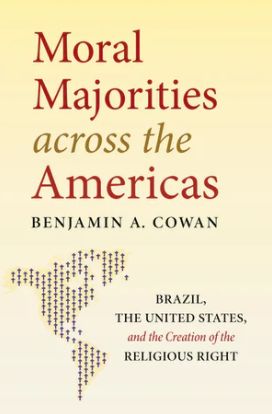|
John Horvat II
Evaluating the Spectacular Impact of the Religious Right
|
|
|
One of the trials in being conservative is that the liberal media likes to give the idea that our actions occur in a vacuum. The more liberal the media, the more insistent is the claim that conservative action has no impact. Consequently, the more conservative the organization, the less coverage, favorable or otherwise, can be expected from the mainstream. This was especially true before the Internet, when the news was more controlled by major media. Thus, when we write our histories, we must confront the official narrative that assigns us no importance. When we insist upon our role in shaping public policy, we risk appearing pretentious, lacking official proof from the past. Another Source Tells Our Story The book Moral Majorities across the Americas: Brazil, the United States, and the Creation of the Religious Right (University of North Carolina Press, 2021) is a history that runs the blockade. Liberal author Benjamin Cowan tells the history of the religious right spanning two continents starting from the sixties. While sharing nothing of our perspective, he tells our story for us. He frees us from making a pretentious attempt of writing our history. His narratives contain errors, misconceptions and hostility toward our cause. However, the book validates our actions over the years by documenting their effectiveness. It helps us see that our efforts were well worth the effort. The Most Politically and Culturally Influential Phenomenon of Our Time Of course, this was not his intention. Quite the contrary. His purpose is more to warn than inform. Sensing the strength of the religious right today, he seeks to answer the question: How did we get here? Thus, the assistant professor of history at the University of California-San Diego presents one of the most spectacular political stories of the late twentieth century. It is an untold story that the writer admits is ignored by academia. Yet, he recognizes the importance of “the construction of today’s transnational Christian conservatism, which has become perhaps the most politically and culturally influential phenomenon of our time.” “Half a century ago, much of what now goes unquestioned as mainstream conservatism was instead the agenda of a reactionary and fundamentalist fringe,” the author continues. “Brazilian conservatives, working with counterparts abroad, laid the groundwork for the normalization of that agenda, the tenets of today’s religious Right.” Action During the Council In covering the vital Catholic role in forming this threatening movement, the author provides an extensive chronicle of the actions of Societies for the Defense of Tradition, Family and Property (TFP) and the Brazilian TFP’s founder Prof. Plinio Corrêa de Oliveira. He traces the resurgence of the Catholic right to the “Coetus,” a group which the TFP organized as a clearinghouse of conservative views working to influence the Second Vatican Council. This effort provided the groundwork for a program that embraced “anticommunism, moralism, antiecumenism, hierarchalism,” and “affinity for the supernatural in the face of perceived secularism.” This anti-modernist platform would later find support and “allies within and outside Brazil, and within and outside the Catholic Church.” The New Right Forms Networks Two strategies changed the course of the debate in the eighties. The first was the wedding of economic liberalism to social, cultural, and religious conservative issues. The second was the formation of broad networks of conservatives who could unite in fighting against communism, immorality and secularism while agreeing to disagree about religion. Key players in this battle were American activists Paul Weyrich and Morton Blackwell, who formed the New Right of the Reagan era. In Brazil, the TFP played a crucial role in developing similar networks. They all still work together, as indeed leftist networks have done for decades. Prof. Cowan warns that this ability to “effectively formulate strategies and messaging” should make liberals take the right seriously in our days. The detailed account of the names, places and circumstances of these networking efforts shows that these actions did not take place in a vacuum. Some people took notice. They had their impact and importance. “Spectacularized Medievalesque Pomp” However gratifying this recognition might be, a final observation should encourage those dedicated to our cause. The author criticizes yet reveals the immense appeal of the religious right’s message. He credits this attraction to our ability to address “the demythification or demystification” of the modern world and “the dismantling of ancient hierarchies.” Conservatives perceive “the mourning of a world without mystery.” Of course, he sees these conditions as something negative. The life of grace, “mysticism and the everyday sense of the divine” are concepts that do not fit into his secular mindset. Thus, he tends to dismiss them as nostalgic notions of a medieval sacral past. However, this belief in a world of mystery and wonder is “the glue” binding the religious right together, seeking “a return to medieval cultural and religious forms.” Thus, the author admits the tremendous attraction of this spiritual dimension. At the same time, he ridicules the TFP for having “spectacularized medievalesque pomp, gaining fame in the 1960s and thereafter for flamboyant street demonstrations.” Exploring Alternatives Such a profound worldview should be embraced, not rejected. The decaying liberal order is sterile and depressing. Its narratives that once unified families, communities and nations no longer survive in our postmodern wasteland. Secular explanations of life deprive it of meaning and purpose. The present disorder offers little hope for the future. Thus, traditional Catholics do not need to apologize for their fascination with mystery and grace. Prof. Cowan’s emphatic insistence on the power of these concepts serves to prove them true, not false. A well-structured social order based on the rule of law, Christian charity and a sense of wonder is the valid alternative to postmodernity’s dismal failures. The world hungers for the divine and yearns for legend and myth. We are convinced of this. Still, it helps that others hear it from someone who tells our story—albeit from the other side. |
|



